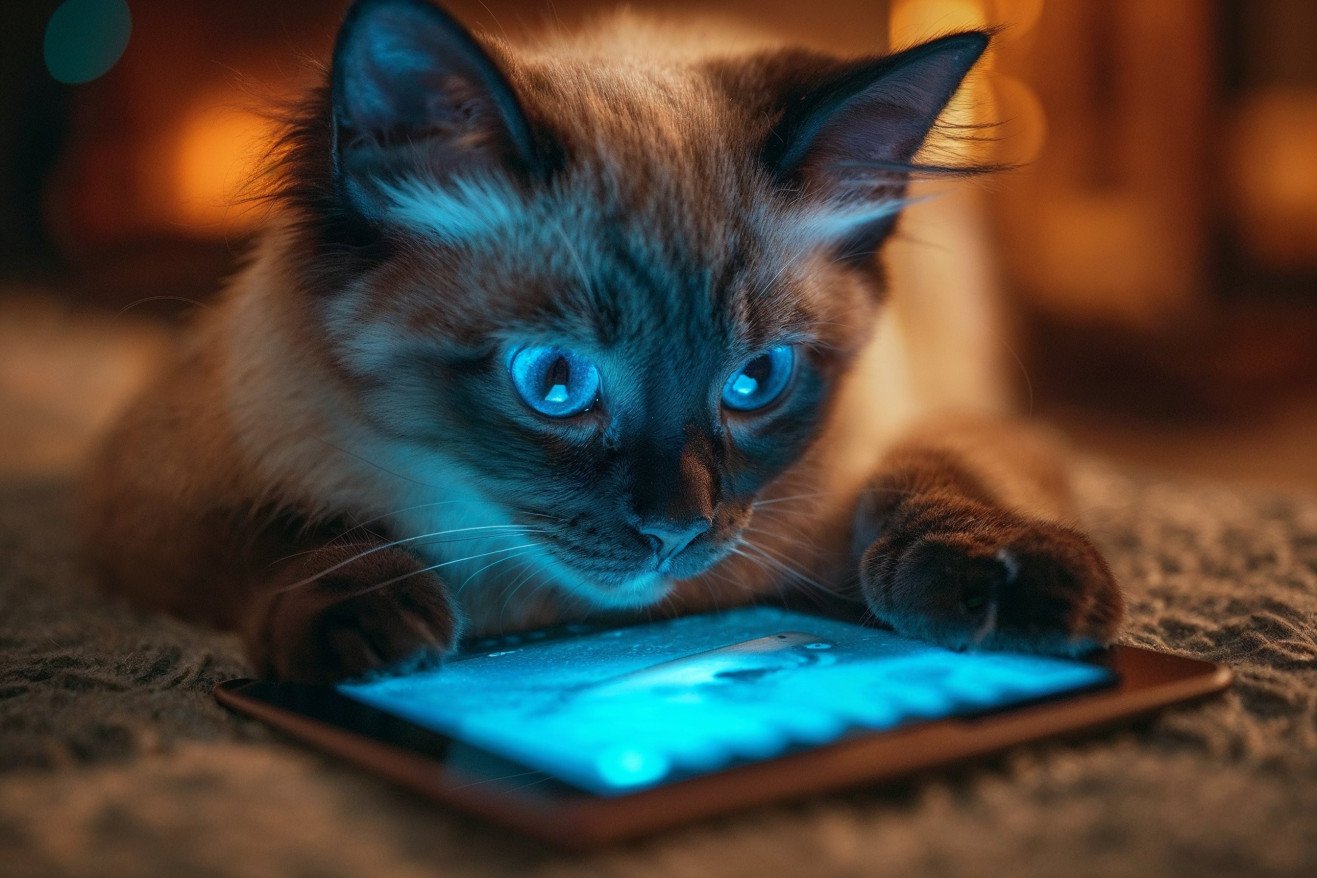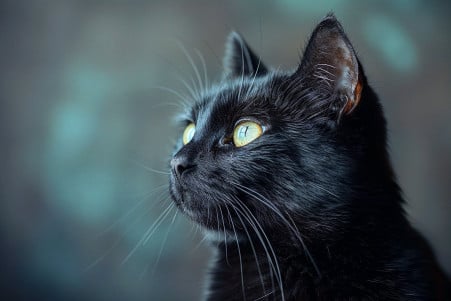Can Cats See What’s On-Screen? Exploring the Depths of Feline Screen Time
30 January 2024 • Updated 30 January 2024

Cats are known for their intense focus on screens, but what do they actually understand about what they’re seeing? Cats can see images on screens and are drawn to fast-moving objects, a trait that harkens back to their days as hunters. While they don’t understand the content the way humans do, the high definition of today’s screens can still hold their attention and provide mental stimulation and enrichment.
To better comprehend this digital mystery, we will review a variety of studies from the fields of animal behavior, cognitive science, and visual perception. We will look at how cats’ visual systems function and how they compare to the technology used in today’s screens.
This will help us determine how much cats understand about what they see on screens, and in the process, we’ll uncover an intriguing intersection of animal cognition and technology that will help you better understand your cat’s relationship with screens.
What aspect of television or computer screens are cats most likely to respond to?
Seeing the World Through a Cat’s Eyes
Cats have a visual system that’s very different from humans, and it’s adapted to their nocturnal hunting lifestyle. For example, cats have a wider field of view than humans, about 200 degrees compared to our 180 degrees, which means they can see more of the world around them without moving their heads. This wider peripheral vision may be why cats are so interested in the moving images on screens.
In addition, cats have six to eight times more rod cells than humans, which are the cells in the retina that help us see in low light, according to Business Insider. This means cats can see much better in the dark than we can, which is why they can see the movement on screens even when the lights are dim.
While we see the world in a rainbow of colors, cats see a much more muted version of the world. Cats have limited color vision, with the ability to see some shades of blue and green, and they may see reds and pinks as a shade of green, according to Business Insider.
As a result, the colors on a screen may not be as bright or varied to a cat as they are to us. But vision isn’t the only sense cats use to understand the world around them.
Their hearing and sense of smell are also important.
When it comes to screens, the sounds that come from them can attract a cat’s attention or let them know that there’s something that might be ‘prey’ on the screen.
The combination of vision, hearing, and possibly smell allows cats to respond to the experience of watching a screen, even if they don’t understand it the way humans do.
This has interesting implications for how cats interact with electronic screens, as their senses determine how they experience our technology-filled world.
The Cognitive World of Cats and Screens
In the world of cognitive science, cats also demonstrate some interesting abilities when it comes to processing visual information from screens. According to PMC, the studies it cites show that cats have some cognitive skills that were once thought to be unique to humans. So, while cats’ reactions to screens are visual, they also have a cognitive component that involves object and animal recognition.
PMC’s review of comparative cognition also notes that cats have some basic cognitive skills that may be the basis for behaviors that we think of as part of human culture, like watching and reacting to screens. This is backed up by a study in Scientific Reports that found that cats can learn to recognize their names, which suggests that they can associate specific sounds with visual stimuli.
In addition, the studies cited by PMC that looked at cats’ ability to recognize emotions found that cats can form a general mental representation of emotions, which may affect how they process on-screen images.
Cats have been shown to have different reactions to human and conspecific (i.e., other cats’) emotional expressions, and this, combined with their interest in moving images, may indicate that they have a deeper understanding of the visual content they see on screens.
So, to fully understand how cats perceive screens, it’s important to consider their cognitive responses to the content they see, which may have implications for how we create visual media for pets in the future.
Making Sense of Pixels: How Cats Perceive Screen Technology
The details of screen technology, especially refresh rates and resolutions, are key to how cats perceive on-screen motion. According to Biology Stack Exchange, cats need at least 100 frames per second to see images on a TV as moving, a far cry from the 16 to 20 frames per second that humans can perceive as continuous.
This is closely related to the critical flicker fusion frequency, which is the lowest frequency at which a light source appears to flicker to an observer. Cats may perceive the refresh rate of a standard screen as flicker rather than smooth motion, which could affect their ability to engage with the content.
On the other hand, modern high-resolution displays, such as Apple’s Retina screens, may be more appealing to cats, as Scientific American notes. These screens may be more in line with cats’ visual abilities, although the direct impact is still up for debate. However, just as high resolution doesn’t guarantee a better viewing experience for humans, it may not for cats either, whose vision is different in important ways.
It’s important to understand how different animals, including cats, perceive time and motion on screens, as a study from Trinity College Dublin points out. Smaller animals with faster metabolisms may perceive time more slowly, which could affect their ability to process rapidly changing images on a screen.
As technology continues to evolve, the question of whether it can be used to enrich or stress animals like cats is increasingly important, especially when it comes to the question of whether screen media is appropriate for our feline friends.
Making Sense of the Digital Impact: How Cats Respond to Screen Time
Cats’ reactions to screen time can tell us a lot about their mental health. Dr. Jillian Orlando, a postdoctoral research scholar at North Carolina State University College of Veterinary Medicine, says that some cats are more interested in watching TV than others.
Still, even the most indifferent cats show some signs of mental engagement when they watch TV, like increased attention to the screen when it shows prey-like movements. This is especially true for indoor cats, who have fewer opportunities for mental stimulation.
In fact, a study in ScienceDirect showed that showing cats in rescue shelters videos of natural prey can be a form of environmental enrichment.
That said, there’s a point at which mental engagement turns into stress. Cats that are too interested in the screen, especially if they’re trying to catch the animals they see on it, can become frustrated or even hurt themselves.
Dr. Orlando suggests that cat owners limit their cats’ screen time and use toys to help them engage with the screen in a safe way, like by playing with a toy that moves in response to the on-screen action.
In light of this research, we can see that there are some potential benefits to letting indoor cats watch TV. However, it’s important to make sure that screen time is just one part of a larger plan to keep cats mentally and physically engaged.
In this way, we can help ensure that cats’ mental health needs are met and that they have a variety of experiences that are in line with their natural instincts and preferences.
Watching the Screen: A Comparative Perspective
One of the most interesting differences in screen-based interactions is between cats and other animals, especially dogs. Cats, with their better night vision and wider peripheral vision, may perceive screen-based motion differently than dogs.
Dogs, with their better motion sensitivity and ability to see flicker rates up to 75Hz, may perceive screen-based motion differently, as Psychology Today points out. Dogs’ increased sensitivity to flicker means that they may see the images on a screen as a flickering series of images rather than a continuous scene, which could affect their interest in what they see.
As The Wildest notes, dogs, like cats, have dichromatic vision, but whether or not a dog will be interested in a screen depends on the breed and the individual dog. However, dogs’ interest in a screen can be increased by content that includes dog barking, which suggests that multisensory integration plays a role in their screen-based interactions, something that’s likely true for cats as well.
A study in the Royal Society Open Science found that both dogs and humans preferred social interactions during gaze, which suggests that dogs are sensitive to social cues in screen-based content. This comparative perspective helps us understand animal minds, showing that while cats’ interest in screens is likely based on the way they perceive motion, dogs’ interest is likely based on social and auditory cues in the content they watch.
These nuances help us understand the complexity of sensory systems across species and make our pets’ interactions with the digital world even more interesting.
Through the Cat’s Eyes: What Science Tells Us About Cats and Screens
This review of the literature on cats and screens has covered a lot of ground, from the visual and cognitive abilities of cats to their behavioral responses to the technological aspects of screens that impact how cats perceive them. Throughout, it has become clear that while cats can see and are interested in what they see on screens, understanding screen content in the way humans do is still a long way off.
Research has shown that while cats’ vision is different from humans in terms of acuity and color perception, they have a highly developed ability to perceive motion, which makes screens potentially interesting to them.
Meanwhile, cognitive research has shown that cats can recognize images on screens, and behavioral research has shown that some exposure to screens can be enriching for indoor cats as long as it’s managed to make sure it doesn’t stress them out.
The intersection of animal cognition and technology is an area ripe for future study. Meanwhile, understanding and observing how our cats interact with screens can help us as pet parents better understand and bond with our pets. The research we’ve summarized here sets the stage for future discoveries and helps us appreciate the unique way our cats see the world—a world that’s increasingly filled with the light of digital screens.


